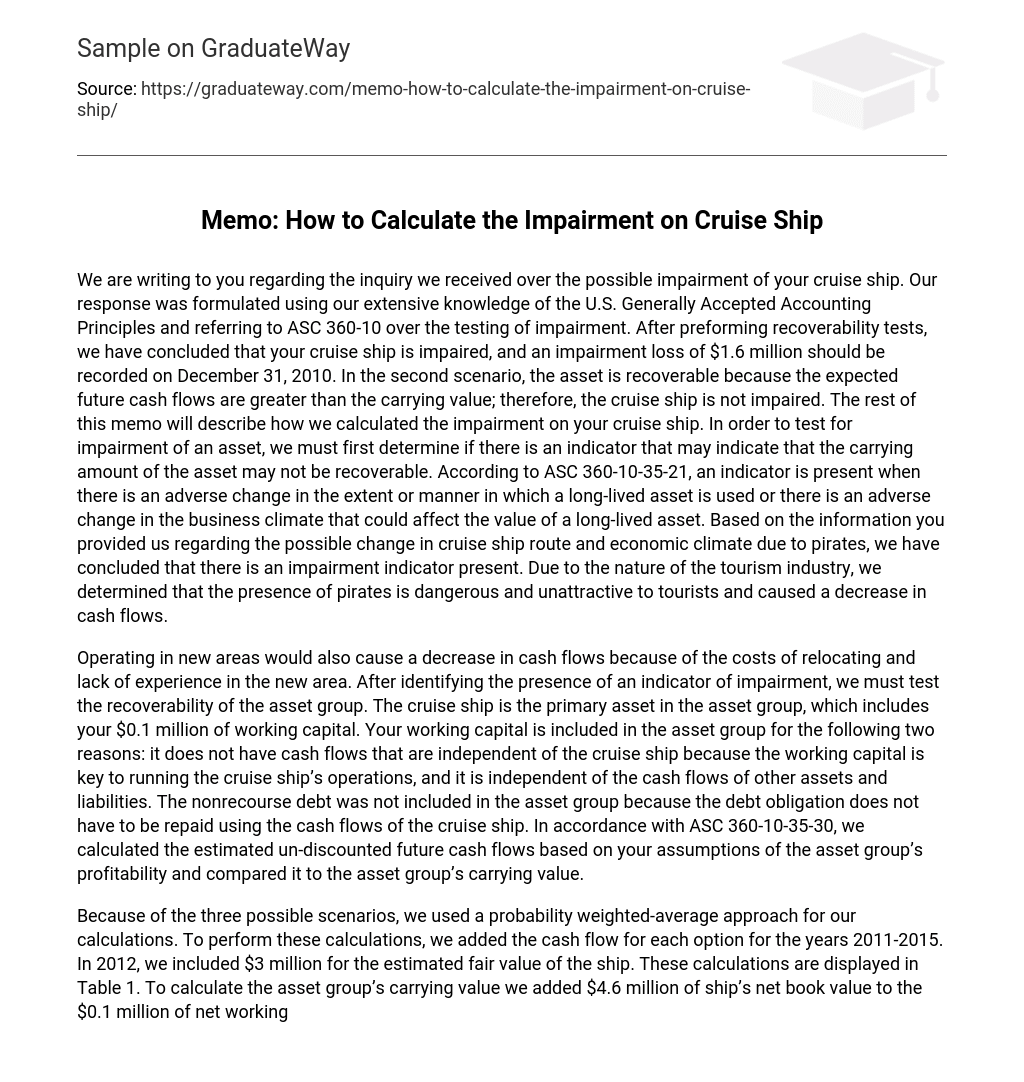Our analysis of your cruise ship’s potential impairment involved the use of U.S. Generally Accepted Accounting Principles and referencing ASC 360-10 for guidance. Based on our recoverability tests, it has been determined that your cruise ship is impaired, resulting in an impairment loss of $1.6 million to be recorded on December 31, 2010.
In a different scenario where expected future cash flows exceed the carrying value, the asset would be considered recoverable and not impaired. This memo will now explain how we calculated the impairment on your cruise ship.
To determine if an asset is impaired, indicators suggesting that its carrying amount may not be recoverable must first be identified. According to ASC 360-10-35-21, such indicators include negative changes in utilization or shifts in the business climate affecting its value.
Based on provided information regarding potential alterations in route and economic climate due to pirate activities, it has been determined that there is indeed an indicator of impairment. Given the nature of the tourism industry, the presence of pirates poses risks and makes it unappealing to tourists, resulting in decreased cash flows.
Operating in new areas would also lead to a decrease in cash flows due to relocation costs and lack of experience. After identifying an impairment indicator, we need to evaluate the recoverability of the asset group. The primary asset in this group is the cruise ship, which includes your $0.1 million working capital. Your working capital is part of the asset group for two reasons: it is essential for running the cruise ship’s operations and its cash flows are not independent of the cruise ship’s. It is also separate from the cash flows of other assets and liabilities. The nonrecourse debt is not part of the asset group because it can be repaid without using the cruise ship’s cash flows. As per ASC 360-10-35-30, we estimated un-discounted future cash flows based on your assumptions about the group’s profitability and compared it to the carrying value of the asset group.
The calculations were performed using a probability weighted-average approach to consider three potential scenarios. The cash flow for each option during the years 2011-2015 was combined. Additionally, in 2012, an estimated fair value of $3 million for the ship was taken into account. These calculations can be seen in Table 1.
To determine the carrying value of the asset group, the net book value of $4.6 million for the ship was added to the net working capital of $0.1 million, resulting in a net carrying value of $4.7 million.
Based on our calculations, it was determined that the asset group could not be recovered as the projected future cash flows of $4.6 million were lower than the net carrying value of $4.7 million.
The total net carrying value of the asset group was $4.7 million, calculated by adding the ship’s net book value of $4.6 million to the net working capital of $0.1 million.
However, it was determined that the estimated future cash flows for the asset group were only $4.6 million, which is less than its net carrying value of $4.7 million. As a result, an impairment loss was recorded.
In accordance with ASC 820, fair value is defined as “the price that would be received to sell an asset or paid to transfer a liability in an orderly transaction between market participants.” The fair value of the asset group consists of two components: a cruise ship valued at $3 million and net working capital valued at $0.1 million.
The fair value of the asset group is $3.1 million, which is less than its carrying value of $4.7 million, resulting in an impairment loss of $1.6 million as of December 31, 2010. Furthermore, we have computed the probability-weighted average for the second scenario and incorporated these calculations into Table 2 for the recovery test. After reviewing these calculations, we have concluded that the asset group can be recovered since its future cash flows total $4.8 million, surpassing its net carrying value of $4.7 million. The findings from the second scenario validate that there is no impairment in this asset.
After conducting an analysis of your cruise ship’s impairment, utilizing our expertise in U.S. Generally Accepted Accounting Principles and guidance from ASC 360-10, we have concluded the following:
- In the first scenario, the asset group is impaired, resulting in a $1.6 million impairment loss.
- However, in the second scenario, there is no impairment loss as the asset group can be recovered.
If you have any further questions or need assistance, please feel free to contact us.





